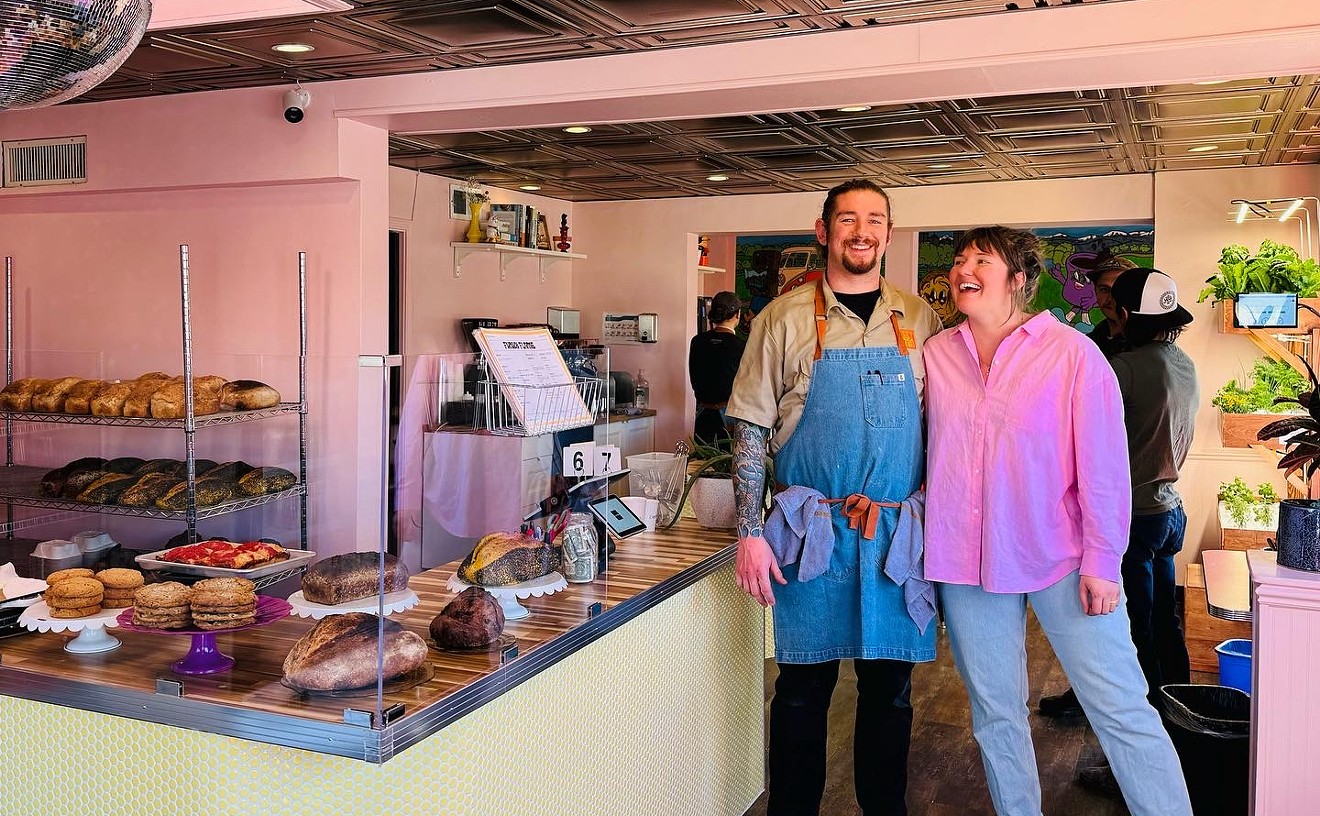Growth and change were the main themes of the past year in Denver — and the restaurant scene was no exception. Fast-paced development has meant more — and more expensive — restaurant spaces, frustrating parking situations, and a wave of newcomers from other states looking for favorite foods they left behind. Most of this year’s big Denver dining stories were a direct result of rapid growth and change, although for one Denver fast-casual chain, its own rapid growth was a factor in making headlines. Here are our top five food-related news stories of the year.
5) Food Poisoning at Chipotle Restaurants
In October, reports began to surface about food-poisoning incidents in Washington and Oregon. The culprit turned out to be E. coli, and fingers pointed to Chipotle Mexican Grill; the homegrown chain closed 43 stores in those two states until the source was found and the restaurants deemed safe. After that, additional cases cropped up in California, Minnesota, New York, Ohio, Illinois and Maryland — a total of 52 in eight states. And then in December, more than 140 guests were sickened with norovirus at one Chipotle outlet in Boston.
While no illnesses were reported in Colorado locations, Denverites were certainly concerned, as the company got its start here. Founder Steve Ells quickly issued an open letter apologizing for the issues and outlining a course of action. “The fact that anyone has become ill eating at Chipotle is completely unacceptable to me, and I am deeply sorry,” he wrote.
If there’s a lesson here, it’s that even “food with integrity” is handled by many people before it hits your plate and ends up in your mouth. We take a risk every time we put food prep into someone else’s hands. Of course, most of us won’t return to preparing all of our food at home — but even if we did, there are still no guarantees that grocery-store food is completely safe. So we’ll continue to enjoy restaurants for the social experience and for great food — but maybe with a touch more apprehension at each cough or sneeze we overhear.
And just last week, a new strain of E. coli was isolated after five more people reported illnesses after eating at Chipotles in North Dakota, Kansas and Oklahoma. The incidents were tied to meals purchased in late November, and the company responded on its website by stating, “None of the ingredients in our restaurants today were present at the time of these illnesses.” Still, the widespread incidents and continuing reports set Chipotle up to be this year’s Jack in the Box.
4) Restaurant Closings
The total number of restaurants in metro Denver that called it quits this year wasn’t that different from last year’s tally — around a hundred each year. But with fewer openings, the places that shuttered in 2015 — especially those we’ve counted as perennial favorites — made us mourn just a little more. Starting with the loss of Paris on the Platte in January when longtime owner Faye Maguire decided to retire, and culminating with the sale and subsequent closure of Tom’s Home Cookin’ at the beginning of December and the upcoming end of Andre’s Confiserie Suisse, we’ve witnessed restaurateurs closing up shop for a number of different reasons. Trillium, Fuel Cafe and Lower48 Kitchen all garnered critical praise in the Ballpark and River North neighborhoods, but the skyrocketing cost of doing business in a hyper-competitive market proved too burdensome.
Others, like the Rustic Tavern, Le Central and Rosa Linda’s Mexican Cafe, closed because the owners were simply ready to retire.
The value of the underlying real estate certainly had something to do with the sale of Tom’s, which reportedly sold for several times the amount that owners Tom Unterwagner and Steve Jankousky paid for the property in the 1990s. And Elitch Lanes and the River North Brewery were both forced out by the wrecking ball (though River North is already in the process of rebuilding elsewhere).
Perhaps saddest of all was the loss of three charitable eateries: Cafe Options, which served as a training ground for impoverished women entering the food-service industry; Pizza Fusion, which gave the homeless a place to work; and the Cafe 180 kiosk, a pay-what-you-can sandwich shop on the 16th Street Mall (though the main restaurant on South Broadway is still up and running).
3) The Rise of Food Halls
In the years just after the recession of 2008, food-truck rallies were a big deal — and a good deal for Denver diners seeking choice and value in one location. While the mobile-food movement has faded from its peak years, the idea for a high-occupancy culinary destination did not. Avanti Food & Beverage was the first to debut in Denver this year, with seven shipping-container kitchens devoted to chefs looking for short-term leases in a collaborative space where they can test their concepts and build their brands. Two central bars operated by Avanti make the two-story space a nighttime draw, while food ranging from Venezuelan arepas to Japanese udon-noodle bowls keeps the place packed from lunchtime to last call.
This kind of setup was presaged by the Source, a retail and restaurant space that opened in a massive renovated factory space in 2013 — and other similar concepts were announced this year. The Stanley Marketplace will open in late spring or early summer in the former Stanley Aviation building near Stapleton with more than ten food and beverage spots, and Central Market, from developer Ken Wolf and restaurateur Jeff Osaka, will bring thirteen local food vendors together under one roof on Larimer Street in the spring.
While all of these could be seen as the equivalent of mall food courts without the surrounding mall, the independent spirit of most of the vendors combined with the unique architecture on display mark a new style of culinary diversity.
2) The Rebirth of Cherry Creek
The blocks of shops and restaurants between First and Third avenues east of York Street saw their heyday in the late 1990s and early 2000s, with restaurants like Mel’s Bar & Grill, Bistro Adde Brewster and Rodney’s drawing customers from far beyond the neighborhood. But lean years hit during which nothing seemed to stick, whether it was big-name national draws like Wolfgang Puck, critically acclaimed local trailblazers along the lines of Argyll and Phat Thai, or even simple street-food vendors like Hot Dawg and Ay Caramba. For the better part of the years between 2009 and 2014, the once-glitzy zone was seen as fusty and outdated — a place where mink coats went to curl up and die.
But a new wave of development is now erecting boxy concrete and glass condos, apartments, hotels and offices in the area — and tearing down aging buildings — faster than the racks clear out at a Chico’s sale. This has displaced some restaurants, notably the Egg Shell and, most recently, Opus Fine Dining, but newcomers are taking advantage of the new street-level retail spaces being created.
This year brought Blue Island Oyster Bar, the monstrous Del Frisco’s Grille and Osaka Ramen, along with a refurbished Cucina Colore — which nearly doubled in size — and a new home for longtime Lakewood Japanese favorite Kobe An. But that’s just the beginning: Still in progress, with opening dates scheduled for the next few months, are Sol Cocina, Departure, 801 Chophouse, Matsuhisa and the Thirsty Lion — all of which are national chains or transplants from other states.
Even California Pizza Kitchen and Kona Grill, on the mall side of First Avenue, embraced the rejuvenation movement and reopened with facelifts and refurbished menus this fall. How many of the newcomers will survive? It all depends on whether Denverites are willing to flock back to Cherry Creek or if tourist dollars will fuel the current fire, only to have that die out when this foodie fad runs its course once again.
1) The Fiftieth Anniversary of Larimer Square
Larimer Street has a long and colorful history dating back more than 150 years, but much of it fell into blight and was recognized as a skid row by the mid-1900s, when many old buildings were demolished in the name of progress. But fifty years ago, Dana Crawford realized that there was plenty of history to be saved — especially on an untouched block between 14th and 15th streets — and so worked with city officials and investors to create Larimer Square, Denver’s first official historic district. Crawford has remained active in developing and promoting the Square, which celebrated its fiftieth birthday throughout the summer and fall. Originally a draw for tourists — who would eat at the Magic Pan, while locals stuck with Cafe Promenade — in the 1990s Jeff Hermanson took the reins from Crawford, establishing Larimer Associates and introducing the concept of local chef-driven restaurants. As a result, today Larimer Square is one of the city’s most vital and stable restaurant zones, with very little turnover and plenty of unique concepts from Denver’s top restaurateurs.
Jennifer Jasinski and Beth Gruitch opened Rioja in 2004 and later added Bistro Vendôme and Euclid Hall to their collection. Frank Bonanno began with Osteria Marco in 2007 (after establishing Luca and Mizuna in Governor’s Park several years earlier), then opened Green Russell and Russell’s Smokehouse across the street. Troy Guard got in on the act with his flagship TAG in 2009, then went belowground with TAG|Raw Bar, which he converted to Bubu in 2014.
While old favorites like the Market and its timeless deli still draw customers, Larimer Square still finds space for newcomers: This year saw the opening of Milk & Honey Bar-Kitchen, which made our year-end list of the fifteen best new restaurants in Denver.
With Larimer Square’s historic-district designation, development and growth there have been slow and regulated — unlike in some parts of downtown that are becoming nearly unrecognizable. While the architecture may not change, Denver’s restaurant visionaries are making sure that the block remains a vital part of the culinary scene.
[
{
"name": "Air - MediumRectangle - Inline Content - Mobile Display Size",
"component": "12017618",
"insertPoint": "2",
"requiredCountToDisplay": "2"
},{
"name": "Editor Picks",
"component": "17242653",
"insertPoint": "4",
"requiredCountToDisplay": "1"
},{
"name": "Inline Links",
"component": "18838239",
"insertPoint": "8th",
"startingPoint": 8,
"requiredCountToDisplay": "7",
"maxInsertions": 25
},{
"name": "Air - MediumRectangle - Combo - Inline Content",
"component": "17261320",
"insertPoint": "8th",
"startingPoint": 8,
"requiredCountToDisplay": "7",
"maxInsertions": 25
},{
"name": "Inline Links",
"component": "18838239",
"insertPoint": "8th",
"startingPoint": 12,
"requiredCountToDisplay": "11",
"maxInsertions": 25
},{
"name": "Air - Leaderboard Tower - Combo - Inline Content",
"component": "17261321",
"insertPoint": "8th",
"startingPoint": 12,
"requiredCountToDisplay": "11",
"maxInsertions": 25
}
]











